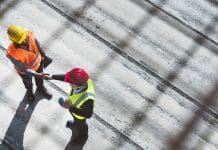We spoke with Vicki Reynolds, chief technology officer at i3PT and Obi about diversity, women in digital construction, and how the industry can bring new entrants into the sector
“Over the past few years I believe we have seen increased numbers of women in digital construction, alongside members of the BAME and LGBTQ+ communities, and people from different socio-economic backgrounds, but we’re still a long way from being truly representative of the communities that we build for.”
Can you tell us about your job role?
I am the chief technology officer for an organisation called i3PT. We provide several key services to the construction industry including but not limited to Quality Assurance, Technical Advisory, Design Reviews, and ESG Consultancy.
We’re completely independent, and everything we do centres around driving positive change for the built environment. We also have a software platform called obi, which enables our users to manage quality, compliance, and sustainability deliverables in a simple yet effective way.
I look after the strategic roadmap for obi, design new features, and support our brilliant Head of SaaS Operations with the day-to-day management of the team and task management. I am also responsible for information security across i3PT, including the maintenance of our ISO 27001 and Cyber Essentials Plus certifications.
I am also part of several industry groups and initiatives, including the BRAC Golden Thread working group, the Built Environment Panel for the IET, and an ambassador for both the UK BIM Alliance and Women in BIM.
I’m also fortunate enough to be part of the Digital Twin Fan Club core team, where we strive to make subjects like digital twins more accessible, and myth-bust some common misconceptions about data and technology in the built environment. Our podcasts can be found on Spotify, iTunes, and Soundcloud.
What is digital construction and why is it so important?
Digital construction is the use of digital tools and processes to make the delivery of construction projects more efficient. At the heart of digitalisation is better information management, which means that actual and accurate data can be used to aid more accurate and informed decision making.
By using digital tools to collect, store, share, and analyse important information we can make plans and manage change more accurately and sensibly. By implementing digital construction tools and processes across the built environment we can become increasingly more efficient, greener, safer, and stronger.
Is the digital construction industry diverse?
The digital side certainly appears to be more diverse than some other traditional areas of construction, but there’s still plenty of work to do. Over the past few years I believe we have seen increased numbers of women in digital construction, alongside members of the BAME and LGBTQ+ communities, and people from different socio-economic backgrounds, but we’re still a long way from being truly representative of the communities that we build for, which is an important target to strive for.
We certainly don’t seem to have enough representation of disabled people or those with accessibility requirements within our workforce, yet these voices are so important if we’re striving for an inclusive built environment.
How can we improve diversity in the sector in a meaningful way?
Firstly, we need to ensure the industry is attractive to a diverse pool of potential employees. The gender pay gap reports for many organisations in our sector are frankly abysmal, and maternity, paternity, and other important benefits packages are still lacking. If we want to attract a diverse workforce, then we need to make our sites and offices accessible to those individuals. This includes making sure that pay and benefits are fair, accessibility has been considered appropriately, and that women’s PPE and facilities aren’t an afterthought.
We also need to market the incredible career opportunities that are available in construction better to young people and their parents and carers. Our industry offers fantastic career progression and job satisfaction, and yet so many young people don’t see it as a viable and rewarding career option. The digitalisation of our industry will certainly help to attract more talent and create excitement amongst a potential emerging workforce, which is another reason for us to embrace digital tools and technology with arms wide open.
How do you encourage people from more diverse backgrounds to join your workforce?
Whenever I can I try to go into local schools and colleges to talk to young people about construction. The diversity of pupils found in most London schools means that I can reach such a great range of individuals.
At i3PT we also strive for diversity in our recruitment. We review our job descriptions regularly to ensure we’re using inclusive language, and we make it clear to any recruitment agencies that we work with that we’d like to target a wide range of applicants.
Generally, I’d encourage employers to attend schools to talk to a diverse pool of young people and find out what would really attract them to a career in construction. Advertising roles where they will be seen by diverse audiences is also important and making sure that roles are accessible to those who might have taken a career break, such as new mothers, and those looking for a career change later in life. Along with graduate schemes I’d like to see more training programmes for returners and mature learners across our industry.
Would you say that being a woman has made your career in construction more challenging?
At times it has, especially earlier on when I was still learning. Often being the only woman in the room and one of the youngest I often felt particularly visible and vulnerable, meaning that I was very risk averse and would rather stay quiet than risk saying something wrong. I also experienced some very explicit sexism by a manager that I had previously trusted and respected.
Thankfully this was an isolated incident, but I found the process of reporting and dealing with that situation extremely stressful, and I had to push very hard for support and a resolution. I was very close to leaving the industry all together, which I now know would have been a huge shame.
Later in my career, as my confidence had grown, I’d say that being woman has also had some great advantages. An example would be the incredible community I found though Women in BIM. There are around a thousand female members of Women in BIM globally, plus hundreds of fantastic male advocates and allies.
Some of the people I’ve met through that group have become more than just colleagues, they are genuine friends, and the supportive community there is something genuinely unique.
If you could give some advice to young people wanting to enter the construction industry today what would that be?
Do it! As an industry we are going through a period of immense change and improvement, meaning that it is exciting, challenging, and extremely rewarding. I love my job because I have the opportunity to make a genuine impact on the built environment. I’ve worked with some incredible people, and I’ve been able to shift and move through various roles, keeping me interested and excited.
My practical advice would be not to get overwhelmed by the many different roles available – simply get in to the industry and then navigate your own career from there. Many colleagues of mine are now working in completely different disciplines to which they originally trained, using past experiences and new skills to really make their roles unique.

















